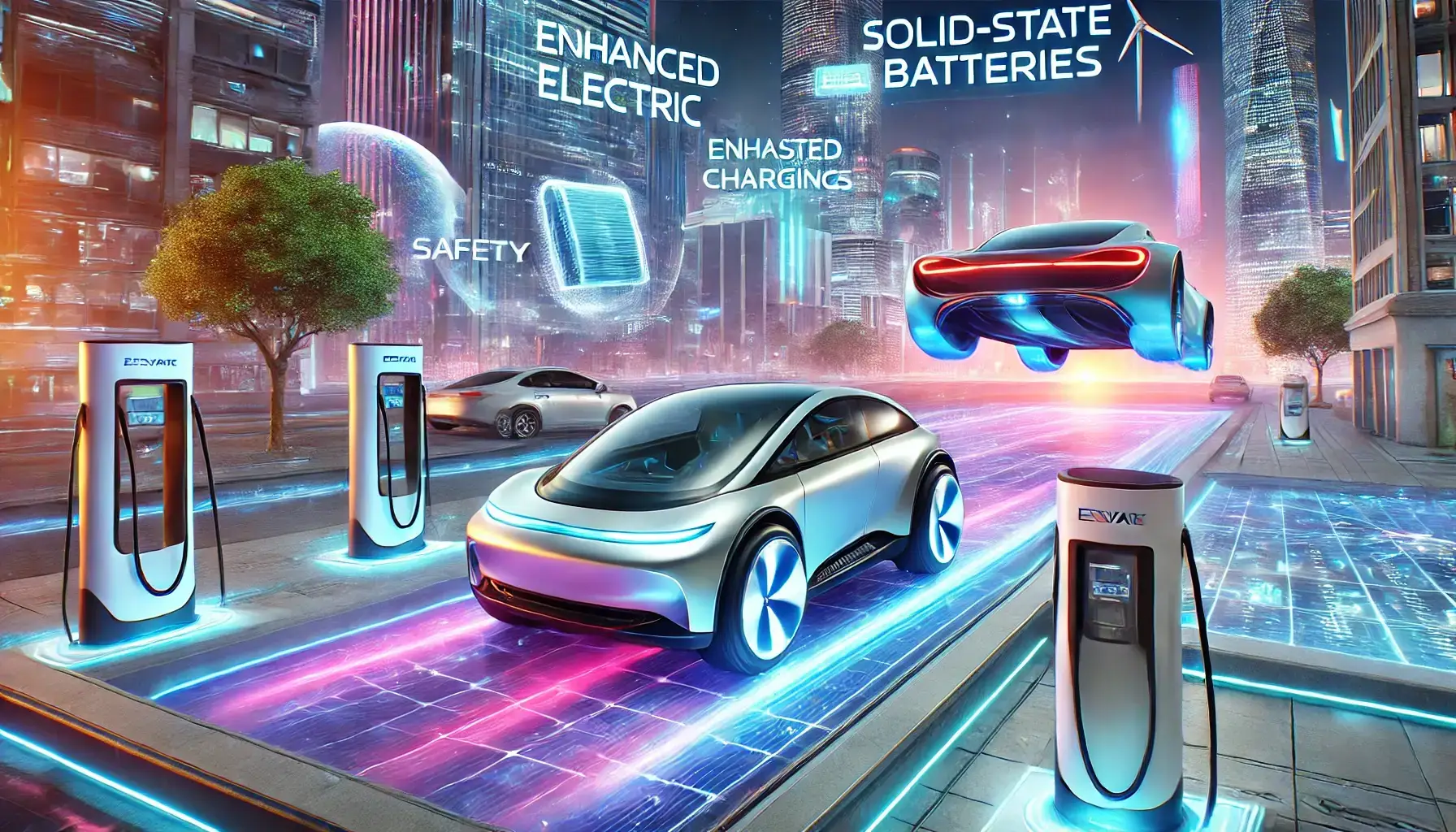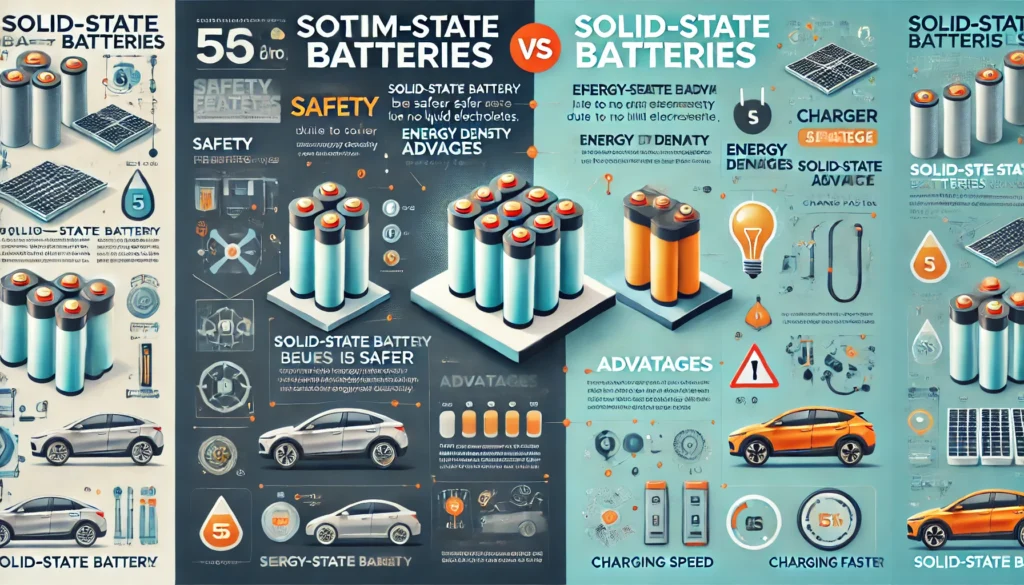Last Updated on March 15, 2025

🚗 Introduction
Electric vehicles (EVs) have transformed how we think about transportation. As the EV market continues to expand, current lithium-ion battery technologies have encountered limitations in terms of range, charging times, and safety concerns. Enter solid-state batteries for electric vehicles, a groundbreaking innovation promising to overcome these barriers and redefine the EV landscape.
This article explores solid-state battery technology, its advantages, current challenges, and the key players driving its development, helping EV owners, tech enthusiasts, and potential buyers understand why this technology matters.
🔍 What are Solid-State Batteries?
⚡ Understanding Solid-State Battery Technology
Solid-state batteries differ significantly from conventional lithium-ion batteries. They utilize a solid electrolyte instead of the liquid electrolyte found in traditional batteries. This crucial change enhances battery safety, performance, and overall efficiency.
Solid electrolytes are typically ceramic, glass, or polymer-based materials, providing stable, efficient pathways for ions to move between battery electrodes.
🔄 How Solid-State Batteries Differ from Lithium-Ion Batteries
The differences between solid-state batteries and lithium-ion batteries are essential for understanding their impact on EV technology:
- Safety: Solid-state batteries drastically reduce the risk of battery fires, as they eliminate flammable liquid electrolytes.
- Energy Density: Higher energy density translates into more power storage, enabling longer driving ranges.
- Charging Speed: Solid-state technology offers faster charging times, significantly enhancing EV usability.

🌟 Advantages of Solid-State Batteries for EVs
🛡️ Improved Safety and Reduced Fire Risks
The absence of flammable liquid electrolytes significantly lowers fire and explosion risks, making solid-state EV batteries safer. For example, QuantumScape’s research indicates their solid-state cells greatly reduce thermal runaway, a critical issue for EV battery safety.
📏 Higher Energy Density and Increased Range
Solid-state batteries could potentially offer double or even triple the energy density of current lithium-ion batteries. This directly translates into a substantial increase in driving range per charge, effectively addressing one of the main consumer concerns surrounding EV adoption.
⏩ Faster Charging Speeds
A major barrier to widespread EV adoption has been slow charging times. Solid-state batteries offer significantly reduced charging durations, potentially recharging vehicles within 15 to 20 minutes. This technological leap can make EV ownership considerably more practical and appealing.
⚠️ Challenges Facing Solid-State Battery Adoption
💸 Manufacturing and Cost Issues
Despite their advantages, solid-state batteries are currently expensive and challenging to manufacture on a large scale. This manufacturing complexity translates into higher costs, limiting mass adoption. However, companies like Solid Power and QuantumScape are actively investing in developing scalable manufacturing techniques to overcome these cost barriers.
🔧 Technological and Material Challenges
Achieving stable, long-lasting performance with solid electrolytes remains challenging. Durability, particularly in varying weather conditions, has presented hurdles. Continued research into new electrolyte materials, such as ceramic-polymer hybrids, promises greater stability and extended battery life.
🏢 Leading Companies and Innovations in Solid-State EV Batteries
🚘 Major Industry Players
Prominent automotive companies like Toyota, Ford, and BMW are significantly investing in solid-state battery technology. Toyota, for instance, plans to debut solid-state-powered EVs commercially by the late 2020s. QuantumScape, backed by Volkswagen, aims to produce commercially viable solid-state batteries by 2026.
🚀 Innovative Startups Making Waves
Startups like Solid Power, backed by Ford and BMW, are making substantial progress. Solid Power has successfully produced pilot solid-state battery cells, proving their viability and paving the way for large-scale production.
📅 Projected Timeline for Mass Adoption
Industry experts forecast that solid-state battery technology will begin widespread commercial adoption around 2027-2030. Early adopters could see vehicles featuring solid-state batteries as soon as 2026, marking a major industry shift towards safer, more efficient battery solutions.
🌿 Environmental Impact and Sustainability
🌎 Environmental Benefits Compared to Lithium-ion
Solid-state batteries are more environmentally friendly due to fewer hazardous materials. Their simpler, solid-state design makes recycling easier and less harmful to the environment compared to liquid-based lithium-ion batteries. This aligns with global sustainability goals, making solid-state batteries highly desirable for eco-conscious consumers.
♻️ Sustainability Challenges and Opportunities
Despite these advantages, environmental challenges remain. The mining of rare materials required for solid-state batteries poses sustainability issues. Companies are actively researching alternatives and recycling methods to mitigate these impacts, with significant investment in sustainable battery production practices.
✅ Conclusion
Solid-state batteries represent a revolutionary advancement in EV technology, promising increased safety, significantly improved driving range, and rapid charging capabilities. While challenges remain, substantial investment and ongoing innovation suggest these barriers will soon be overcome, reshaping the EV market.
Stay informed about the latest developments in solid-state batteries for electric vehicles by subscribing to our newsletter and exploring related articles such as How Electric Vehicles Work: A Beginner’s Guide, Top 10 EV Charging Stations for Home Use in 2025, Future Car Technologies: Innovations Transforming the Auto Industry, and Lithium-Ion Batteries Explained: Pros, Cons, and Alternatives.